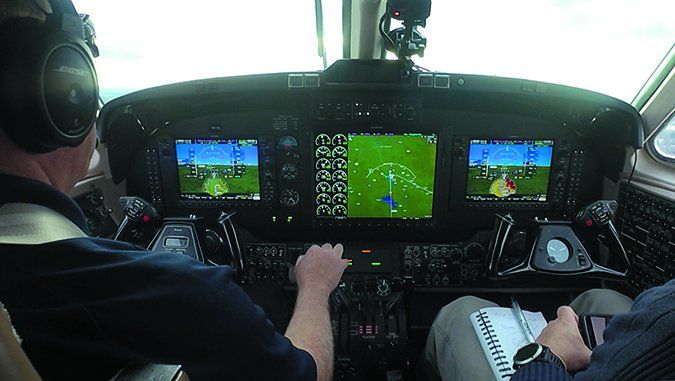In avionics life, 13 years is an impressive production run. That’s roughly the time Garmin’s G1000 has spent at the top of the integrated avionics market. While Garmin has been making incremental upgrades to the system—some major and some minor—it says the latest update, the G1000 NXi, is the most major one to date.
Avionics Flight Test
To see just what the next-generation G1000 NXi brings to the table, we went flying with the system in Garmin’s King Air 350, where it will replace the current G1000 for future King Air retrofits. The G1000 NXi could be the new standard for OEM equipage in a wide variety of airframes. Cirrus has already adopted the system, calling it the Perspective+ .
Evolution Only
Before diving into the next-gen G1000 NXi, it’s worth reviewing the G1000’s evolution because the NXi isn’t revolutionary. When the screens are dark, it’s practically identical to the older system, save for the modern corporate logo on the bezel. How that will resonate with buyers and OEMs expecting a total facelift of the G1000 remains to be seen. On the other hand, if the system is reliable and capable—and in our view the G1000 certainly is—why change it?
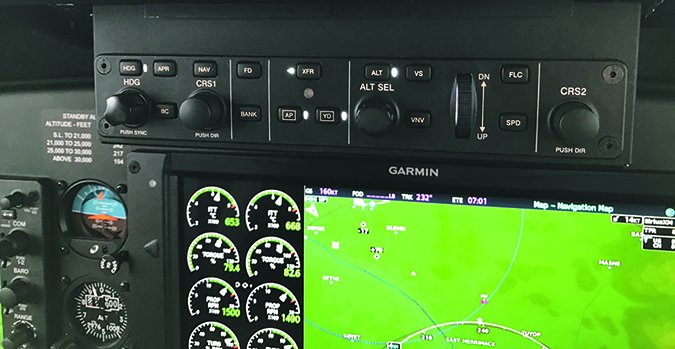
In an interview conducted last year, we asked Garmin why it hasn’t made design changes to the aging hardware as it did with the GTN-series touch navigators. Garmin said the G1000 to this day continues to serve its original intentions: to offer a weight-saving, high-tech, integrated glass cockpit that rescues a market long stuck in the age of steam gauges. Well, that might have been the market then, but that’s not exactly today’s standard. A recent change in regulation has opened the floodgates for low-cost electronic flight instruments—including Garmin’s own certified G5 EFIS—which we think will ultimately pull the plug on iron gyros.
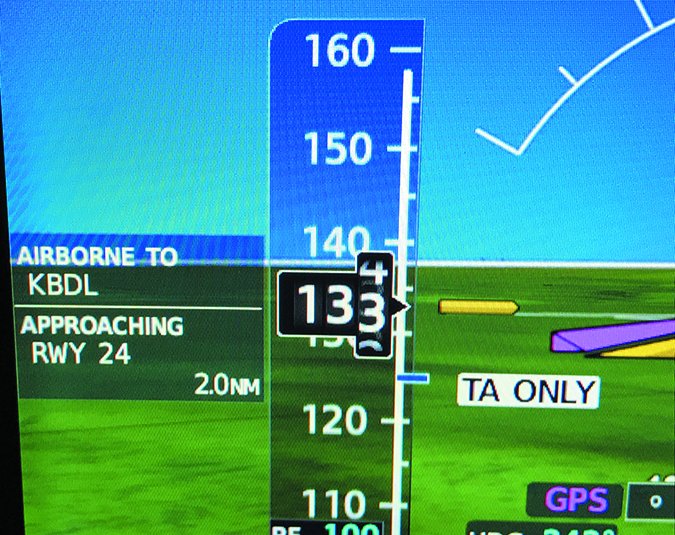
While the GAMA aircraft sales reports continued to show declining new sales of turboprops and jets (yes, pistons, too), the aging iron-gyro-equipped turboprop and light jet refurb market seems brisk—perhaps even lucrative.
Garmin has enjoyed sizable success in that market with its G1000 King Air retrofit program for the 90/200/300/350-series King Airs. As of late 2016, Garmin distributor and service center Elliott Aviation has installed over 450 G1000 systems—more G1000 King Air retrofits than all other dealers in the world combined. It has the process down, proven by its 15-day and $3000 penalty per-day downtime guarantee. In many older King Airs, the project yields a 250-pound weight savings. This includes the new GFC700 flight control system, which Garmin released in 2005.
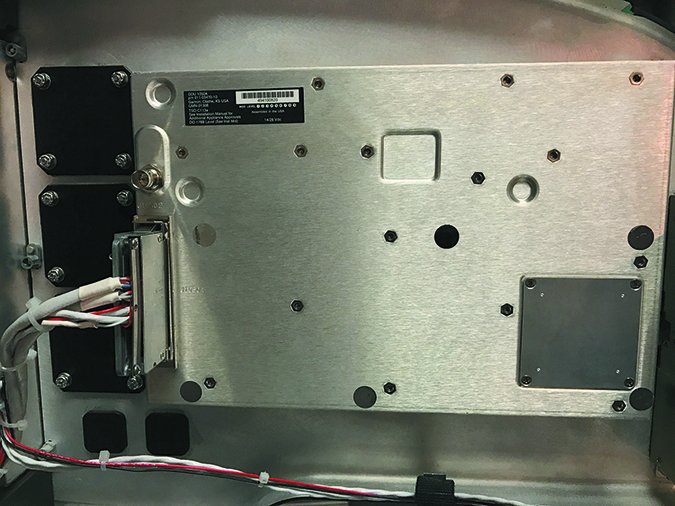
Back then, the GFC700 integrated autopilot was initially certified on the Beech Bonanza and eventually on all platforms. It is since been updated with stability control, plus envelope protection, and is a major subsystem in the G1000 NXi, capable of coupled go-arounds and automatic emergency descent.
We’re awed at the precision with which the GFC700 flies—on all ends of the airframe spectrum. It’s no easy task to make an autopilot fly just as we’ll in a Skyhawk as it does in a beefy 350 King Air. The G1000 NXi retrofit includes complete removal of the old autopilot system and many trash bins of old wiring. Got an old King Air with the primitive AC inverter system? That all comes out, simplifying the electrical bus and overall reliability.
Depending on the aircraft, the user input for the autopilot is either on the PFD or on a dedicated GFC700 control panel. In the King Air retrofit, the panel is placed up near the center of the glareshield so both pilots can reach it. There is also a keypad/joystick FMS panel. In the King Air, it’s in the deep center pedestal—not the best location, in our view—because fingering it does result in some heads-down time. We spotted a better location just forward of the throttles and under the MFD, but the space is occupied by a modern annunciator panel for CAS alerting. While this isn’t a Garmin component, it further modernizes the panel.
Somewhere around 2007, the system got weather radar capability and TAWS-B terrain alerting, electronic charts, Garmin’s SafeTaxi and WAAS GPS. The new NXi supports Garmin’s solid-state GWX70 Doppler-capable weather radar, which also has turbulence detection and ground clutter suppression. Garmin’s GWX radar technology, which started with the GWX68, has put Garmin at the top of the weather radar market, but we thought the presentation could be tweaked and on the G1000 NXi it has.
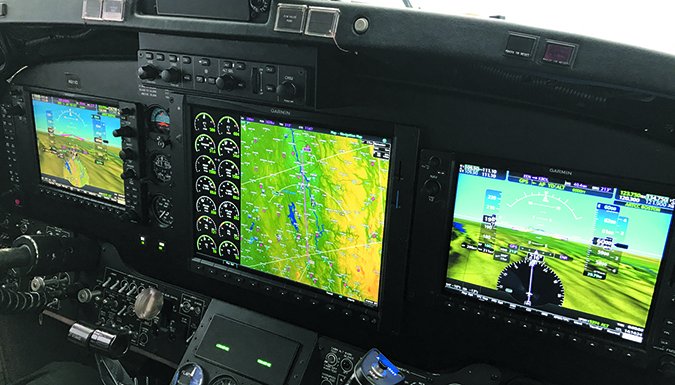
On big-airplane interfaces from Collins and Honeywell, to name two, the weather radar imagery is overlaid where you want it to be when shooting approaches—on the PFD. This function is finally available on the G1000 NXi PFD as a configurable weather source on the new HSI Map feature. More on that in a minute.
Garmin’s ESV (3D synthetic vision) and a 1090ES extended squitter ADS-B transponder came in 2008. Oddly, ESV is optional on the G1000 NXi, enabled through an electronic unlock process. Garmin sells the option as part of upgrade bundle packages. New pricing hasn’t been set yet, but by itself, ESV software is priced at nearly $5000 on the older G1000. Standard is Garmin’s electronic charting or optional Jeppesen data; both have georeferencing, as do the new VFR sectional and enroute charts.
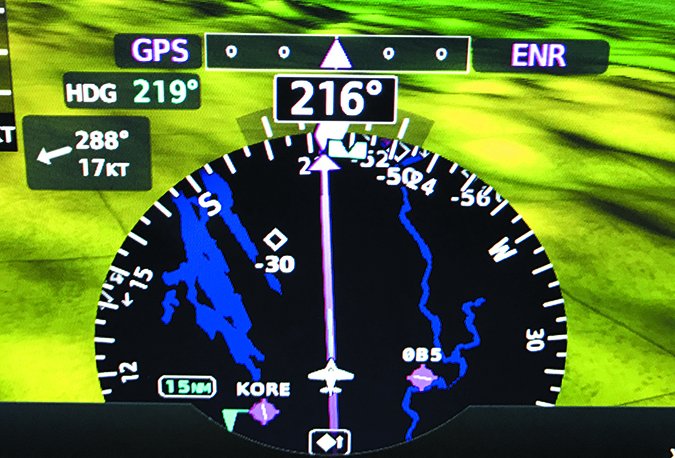
TCAS and TAS active traffic alerting came to the G1000 in 2011, but the G1000 seemed to be at an ADS-B In roadblock. A thorny issue for G1000 owners has been the system’s inability to display ADS-B weather and traffic, but that’s solved in the G1000 NXi (and in many legacy systems) with the GTX345R ADS-B In/Out transponder. Additionally, the weather and traffic can be streamed (via Bluetooth) to tablet computers running the Garmin Pilot app for iOS and Android devices, wireless-equipped Garmin portable GPS systems and the ForeFlight Mobile app for iOS devices. This is accomplished with the Flight Stream 510 MMC-driven wireless module, which also acts a database concierge utility for updating the system’s navigation data, plus two-way tablet/panel flight plan transferring. With a single Flight Stream database stream, the G1000 NXi will synchronize the data between all of the displays in the suite, and database uploads can be done inflight—a time-saving convenience.
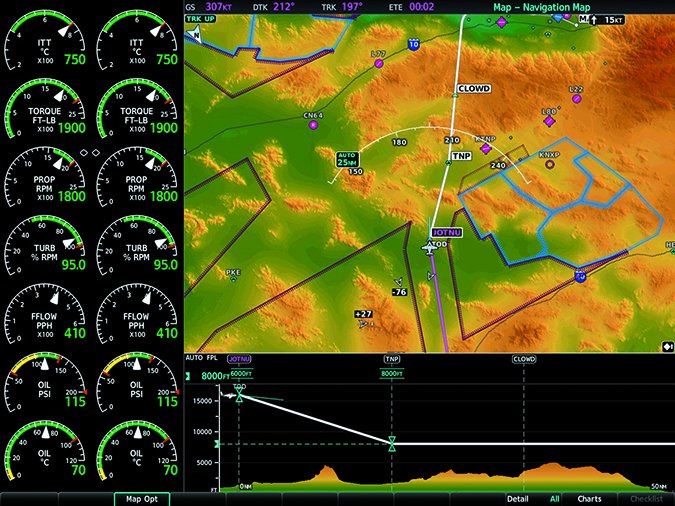
More Horsepower, Better Displays
The major change in the G1000 NXi is the processing power. Switching from a single to a dual-core processor makes the system zip along at nearly twice the speed of the old one. This is obvious a few seconds after you switch on the power. In the old G1000, you wait what seems to be an eternity for the boot cycle to complete before you can access frequencies, listen to the ATIS, enter flight plans and all the other stuff you want to do quickly. We counted less than 10 seconds for the NXi to come alive and be ready for user inputs.
The other benefit of the newer processor is map performance. You won’t have to wait for slow redraws and map refreshes, especially when you pan out long distances. And moving around the map is made much easier with a redesigned cursor-control (CCD) joystick. The action on the old joystick system has 90-degree positions, but the new one is responsive throughout 360 degrees of travel. This speeds data entry and makes it easier to pan the map. We think the new joystick just feels less awkward than the old CCD.
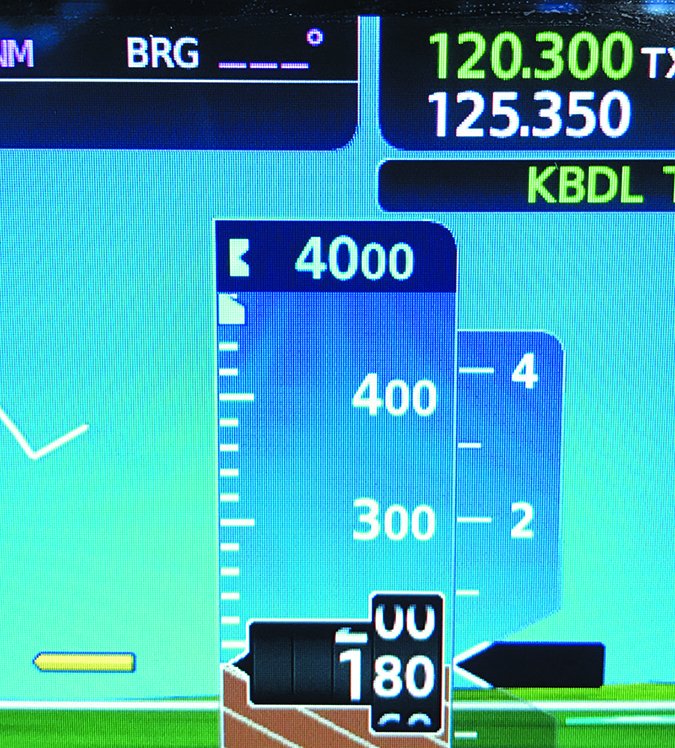
The massive 15-inch MFD that’s standard in the King Air retrofit dwarfs the two 10-inch PFDs and it’s notably brighter and more crisp than the old system. In lesser aircraft, the G1000 NXi will have dual screens and some OEMs might offer 10-inch and 12-inch versions. In general, it’s uncommon for buyers to settle for the smaller displays when given the option, but that could change with the G1000 NXi because the screens are much brighter, thanks to LED backlighting. Garmin also modernized the overall appearance, albeit in a subtle way. The electronic engine gauges are easier to read because they are bolder, plus the various onscreen text boxes are easier on the eyes, thanks to rounded borders.
We especially like the redesigned softkey labels. On the older G1000, activated softkey functions used a grey background, which wasn’t exactly intuitive, in our view. Now their status is better represented with text that’s annunciated in green when a function is active, rather than grey.
Speaking of colors, the MFD and PFD get three-color terrain shadowing, using green, yellow and red contouring to advise how high the aircraft is above the terrain. Green is 2000 feet, yellow is 1000 feet and red is 100 feet AGL in relation to the terrain. That seems more standard.
There is also a new vertical situation display (VSD) on the MFD, which is a customized terrain profile pictorial based on the active flight plan and current winds. As the aircraft cruises along, the terrain below it is depicted in a vertical profile view.
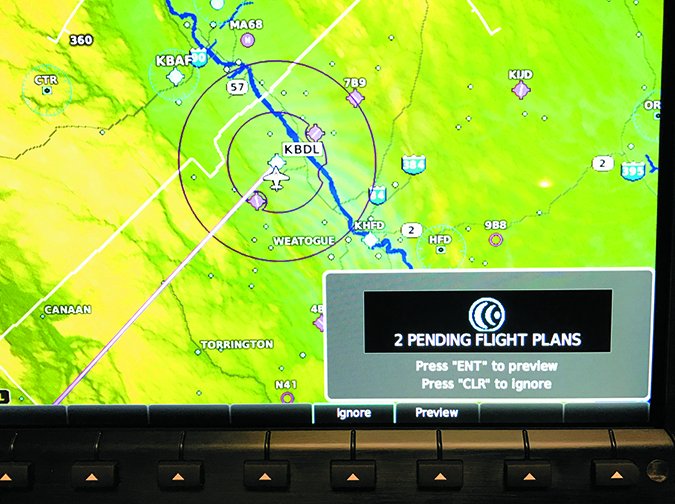
Surface Watch, Configurable HSI
Garmin’s terminal safety software technology originated with SafeTaxi, which is a suite of georeferenced surface charts that display runways, taxiways, FBOs and hangars relative to the aircraft’s location on the field. Hot spots identifying confusing or complex taxiway and runway intersections, as we’ll as hold short lines, are overlaid on the MFD. This isn’t anything new. But the optional SurfaceWatch software takes awareness to a higher level because it creates a backstop against runway and taxiway incursions. It’s also a safeguard against taking off on a runway that’s too short, or taking off or landing on the wrong one altogether.
Arming the feature is accomplished by entering the departing runway while building a flight plan or setting a departure procedure. The system also references the data entered for takeoff and landing performance. In our demo staged out of Bradley International Airport in Connecticut, we set Runway 33 as the departure runway—more than enough pavement to launch the King Air.
But in the event we lined up on a different runway—or one that was too short for our entered performance profile—the system would annunciate a “check runway” or “runway too short” aural alert and visual message on the PFD. SurfaceWatch comes alive as soon as you roll out of the chocks, advising which taxiway you’re on.
SurfaceWatch also works in the background during the takeoff (and landing) roll and displays the runway distance remaining as you haul along. It even monitors your final approach to the runway and advises which one you’re lining up to. Of course, you’ll need to enter the correct data to begin with, but we think the feature can be an effective tool for avoiding overruns. Even if you don’t enter the takeoff and landing performance parameters (you wouldn’t in smaller aircraft, but in jets and turboprops it’s a way of life), you can still manually enter the minimum runway length you can accept and SurfaceWatch will keep tabs on your position.
The new HSI Map function on the PFD transforms the traditional electronic HSI presentation into a pictorial of what you might see on the big MFD. To be honest, initially we weren’t feeling its useful utility, but warmed to it once we went flying.
If you’re a pilot who likes a decluttered display, or are easily overwhelmed by onscreen data, the HSI Map feature might take some getting used to. On the other hand, it’s easily and quickly decluttered—or turned off completely—with “map options” softkeys dedicated to the inlay’s setup.
For example, if you’re flying an ILS or LPV approach, you might want to display a traditional and familiar electronic HSI, which is a clean and straightforward presentation. But, you can also overlay a lot of data. This includes traffic targets from the ADS-B system or from an active TAS/TCAS, plus ADS-B FIS-B Nexrad and METAR data. You can also display the new relative terrain data, ship’s weather radar and lightning data. There is a lot of data that closely surrounds the HSI’s map inset, including the current magnetic heading, the bugged heading , a lateral CDI and a data box with wind direction and speed. If the system has SVT synthetic vision, the inset is overlaid on it. Like we said—it can get busy.
Visual Approach Guidance
Garmin says one of the most requested features by professional flight crews is GPS guidance for shooting visual approaches. Whether for avoiding an embarrassing setup (or worse, a landing) to the wrong airfield, or for backstop when flying published VFR procedures, we think the visual approach guidance is perhaps the NXi’s most useful new utility.
From the NXi’s database, you load a visual approach procedure just as you would any instrument procedure. Once activated, the PFD shows lateral and vertical deviation, plus flight director command bar cues. And, of course, the visual guidance couples to the GFC700 autopilot, where it flies it to the threshold. How does the system compute it?
The VFR guidance you’re flying is an extended centerline from the runway you’re landing on. That’s nothing new; the feature has been in portable GPS systems for years. But you’re also flying FMS VNAV guidance, which on a published visual approach ultimately dumps you into a 3-degree path and on the VASI. You have the option of loading a Straight or Vectored procedure. Again, just like an instrument approach. The Straight transition creates an initial approach waypoint that’s automatically inserted into an active flight plan. The Vectors option is just that—vectors to the straight-in visual. The Straight fix altitude is based below the glidepath intercept altitude for that fix, so the airplane is in a position to capture the glide path somewhere between the Straight and Final fixes.
Also rolling in the background is Garmin’s Surface Watch, which crosschecks the correct runway and annunciates it on the PFD. The Surface Watch communication box lives directly to the left of the airspeed tape.
As we slid down the visual approach to Runway 24 at Bradley International in Connecticut, there was a 2-NM callout and textual “approaching RWY24” alert. Of course, with the SVT synthetic vision option, you’re already looking at a 3D image of the runway environment, and of course the real view outside the windshield.
Wish List
Naturally, it’s easy to be greedy when a major avionics manufacturer touts a system as dominant and major as the G1000 NXi as “next-generation.” As much as we complain that integrated avionics are layers deep, we think buyers want more—even if they don’t use half of it.
Noticeably missing on the G1000 NXi we flew is Angle of Attack data. It’s available on the older G1000 (in Cirrus Perspective applications, to name one) as a third-party input from Safe Flight. A twin turboprop should have it, too. And yes, we think younger buyers might expect a touchscreen interface simply because it’s the new standard in pretty much any piece of electronics. Saying that, we think Garmin has improved the user interface enough—particularly the reworked 360-degree joystick/cursor control and the favorable performance of a faster processor—to say that a touch interface isn’t necessary. But that’s preference.
A good compromise, in our view, would be to replace the mechanical keypad with the touch-controlled FMS used on the G3000 system.
Garmin’s Scott Frye, the sales manager for the integrated flight deck retrofit programs, made it clear that in reworking the system, Garmin was mindful of the $400,000 sweet spot. A from-scratch redesign means costly FAA approval, which gets passed on to the consumer. Because of aging airframes, the King Air retrofit market is less tolerant of higher prices than some may think. There’s also competition from the Collins Pro Line Fusion retrofit program for the King Air—a system with a touch interface. We’ll look at it in an upcoming report.
As we go to press, Garmin is finalizing the NXi’s pricing structure. It estimates that a G1000 NXi step-up from existing G1000s (these owners already likely spent roughly $350,000 for the retrofit) will be around $50,000, with a one-day downtime and new two-year warranty.
Upgrading existing G1000s in other aircraft to the G1000 NXi are up to the OEMs. We suspect that a modern replacement for the aging G500/600 could offer them (and buyers) more options, especially if it displayed engine data.
See a video of the G1000 NXi on Avation Consumer‘s YouTube channel.

